#repatriation of antiquities
Explore tagged Tumblr posts
Text
This is good news!
30 notes
·
View notes
Text

Trajectories and Movements of Filipino People: Diasporic Objects and Possibilities for Rematriation, Marian Pastor Roces (Alliance Français Manila, September 7, 2024)


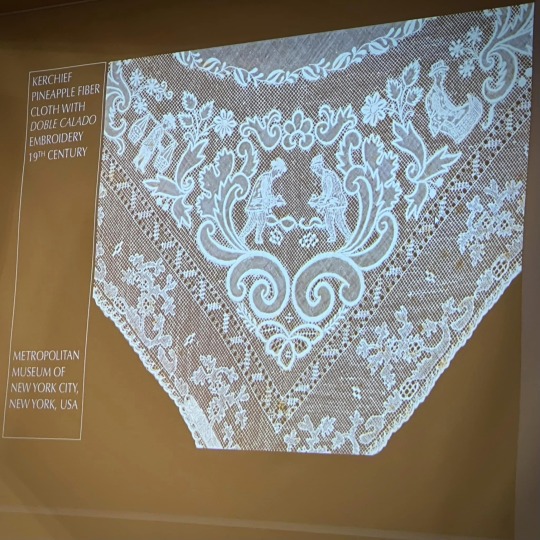

(Photos from Tara Illenberger, Facebook. We attended the same talk, though I was not able to take much photos as much, since I was not seated at the front. 😅)
Would like to start this post by saying that it was such an honor to have met Marian Pastor Roces again. For my would-be followers who are yet to read my blog posts, especially those who are situated abroad, I would like to introduce Marian Pastor Roces to you. MPR is an art critic, museum curator (and creator, in a comical sense), writer, political analyst, and cultural critic. She has hosted the establishments of numerous cultural initiatives that concern cultural heritage of ethnic groups in the Philippines. She is also a writer of essays and books, and an editor for Mapping Philippine Material Culture — a global archive of the different diasporic Filipino art and antiquities.
I met her the first time when I hosted a talk for her at my university. Terrific woman. I wish I had learned about her way sooner, from when I was a kid. Then, I would not have been so indecisive of what I wanted to be when I grew up and knew that I wanted to be a cultural heritage lawyer from the start, haha!
Something this talk proved further was the very principle that
cultural objects have memory too,
much like how much of the movements of Filipino people are reflected in the movements of its cultural objects.
Click read more to read the notes I got from the talk! ⬇️
There were three events that mark as significant events and turning points in the movements of the Filipino people.
Austronesian Migration: Wherein a seaborne migration set sail from the island of Taiwan to Batanes, in Northernmost Philippines. Objects traced and left behind by our Austronesian ancestors revealed marks of cultural connections along their trail.
1887 Madrid Exposition: Wherein maltreatment from the colonial Spaniards sought to display people of the Igorots in Human Zoos. The Filipino people have become an object themselves according to the colonizer.
Philippine Diaspora and Globalization: Wherein Filipino artifacts are now dispersed in cultural and archival institutions globally. Now, the material culture heritage of the Philippines is in large measure overseas. Filipinos do not have access to much of the material evidence of our heritage. Among the outcomes of this unknowing is an abyssmal loss of measures of quality that Philippine Peoples enjoyed until about a century ago.

The substantial collection of the National Museum of the Philippines was nearly totally destroyed during the Second World War, the same event which led to the adopted of the 1954 Hague Convention, briefly discussed in the previous post.
Material Culture Studies were not a significant area of work for Philippine Studies during the Post-War Period.
Philippine Material Culture collections started to be an activity in the 1970's.
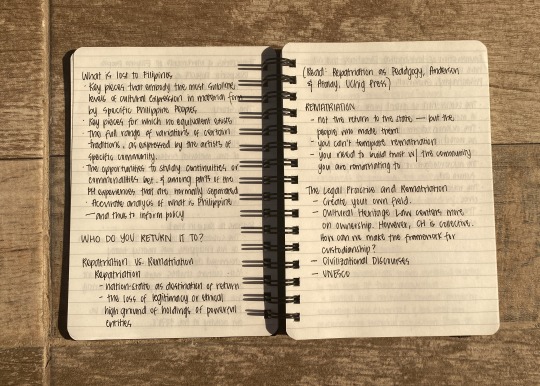
What is lost to the Filipinos, as diasporic objects are detached from them?
Key pieces that embody the most ✨ sublime ✨ levels of cultural expression in material form by specific Philippine Peoples. Here, Marian does not refer to these pieces by the quantity of cultural objects being produced, but by the quality of it. You can get traditional, authentic fabric anywhere in the region where the community resides — but all the ones that were made special, limited, and ceremonious are all stored in museums abroad.
Key pieces for which no equivalent exists.
The full range of variations of certain traditions, as expressed by the artists of specific community.
The opportunities to study continuities or commonalities between and among parts of the Philippine experiences that are normally separated.
Accurate analysis of what is Philippine — and thus to inform policy.

WHO DO YOU RETURN THE OBJECTS TO? Repatriation vs. Rematriation
Repatriation:
Nation-state as destination of return.
The loss of legitimacy or ethical high ground of holdings of powerful entities.
Rematriation:
Not return to the state — but the people who made them.
Though legal processes are able to create a process for repatriation, you cannot template rematriation.
You need to built trust with the community you are rematriating to.
The Legal Practice and Rematriation:
Cultural Heritage law centers more on private/institutional ownership (i.e. cultural property). However, Cultural Heritage is inherently collective. Hence, what we need is a legal basis for cultural custodianship as well — in collaboration in both the communal (discourses among the ethnic group), and international (UNESCO).
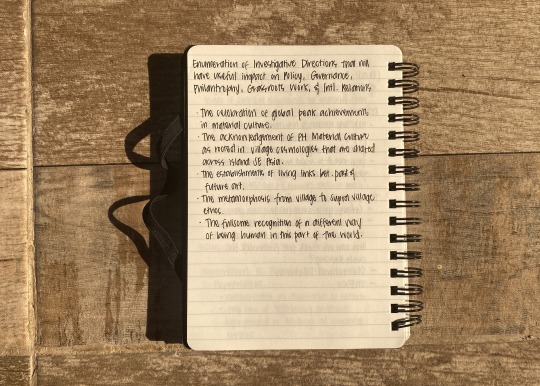
Enumeration of Investigative Directions that will have useful impact on Policy, Governance, Philantrophy, Grassroots Work, and International Relations, with regard to Philippine Material Culture
The celebration of global peak achievements in material culture.
The acknowledgement of Philippine Material Culture as rooted in village cosmologies that are shared across island Southeast Asia.
The establishments of living links between past and future art.
The metamorphosis from village to supra village ethos.
The fullsome recognition of a different way of being human in this part of the world.

#antiquities#culturalheritage#culture#literary theory#society#literature#art#history#museums#museum studies#provenance#repatriation#reMatriation
4 notes
·
View notes
Text
Repatriation of Looted Artifacts: A Victory for Global Antiquities Protection
The repatriation of looted artifacts from the U.S. to India marks a major victory in global efforts to combat antiquities trafficking and protect cultural heritage.
The Celestial Dancer sculpture is one of the pieces in the recent repatriation of looted artifacts from the United States to India. Photo: Manhattan DA The repatriation of looted artifacts from the U.S. to India marks a major victory in global efforts to combat antiquities trafficking and protect cultural heritage. BY ARTCENTRON NEWS The United States recently returned a significant…
#Antiquities Dealer#Antiquities Trafficking#Artifacts Repatriation#Looted Artifacts#Nancy Wiener#Subhash Kapoor#U.S. Authorities
1 note
·
View note
Text
30 Stolen Artifacts Repatriated to Southeast Asia from New York
via AFP/Thai PBS, 27 April 2024: Besides the return of Cambodian antiquities reported last week, New York prosecutors, led by Manhattan DA Alvin Bragg, have successfully repatriated looted antiquities to Indonesia. These artifacts, including a bronze Shiva Triad from Cambodia and a Majapahit bas-relief from Indonesia, were illegally trafficked by dealers Subhash Kapoor and Nancy Wiener. Kapoor…
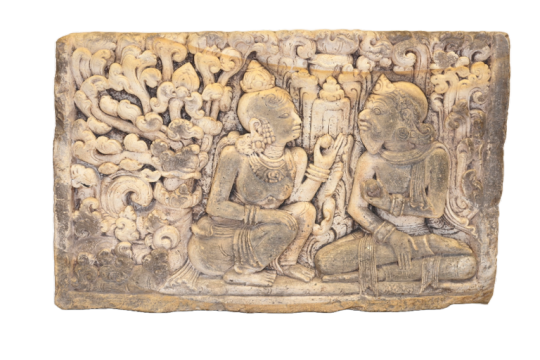
View On WordPress
#Angkor (kingdom)#antiquities trade#crime#Majapahit (kingdom)#Nancy Weiner (person)#New York (city)#relief (sculpture)#repatriation#sculpture#Subhash Kapoor (person)
0 notes
Text

Greece Returns 1,055 Ancient Coins to Turkey
Greece on Thursday returned a hoard of over 1,000 stolen ancient coins to Turkey in the first repatriation of its kind between the historic rivals and neighbors, Agence France-Presse reported.
The move came a few months after Turkey publicly supported Greece in its long quest to reclaim the Parthenon Marbles from the British Museum in London.
Greek Culture Minister Lina Mendoni said the hoard of 1,055 silver coins had been seized by Greek customs guards on the border with Turkey in 2019.
“These coins had been illegally imported,” Mendoni said at a ceremony at the Numismatic Museum, which specializes in currency and medal collections, in Athens.
Greeks are “particularly sensitive” to repatriation issues, she said.
“All illegally exported antiquities from whichever country should return to their country of origin,” Mendoni added.
Turkish Culture Minister Mehmet Nuri Ersoy said the operation was the first repatriation from Greece.
Greek and Turkish experts determined that the coins were part of a stock hidden in Asia Minor between the late 5th and early 4th century BCE, she added.
While research is ongoing, it is possible the hoard was secreted in modern-day Turkey during the Persian Wars expeditions of Athenian general Cimon, a veteran of the 480 BCE Battle of Salamis, she added.
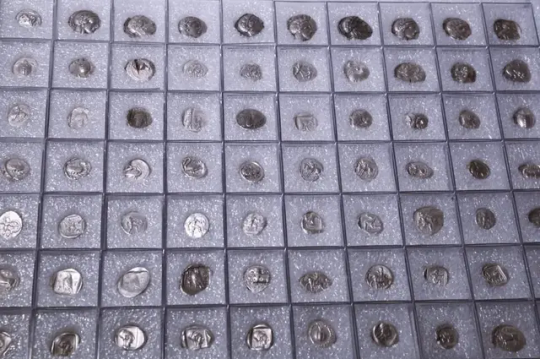

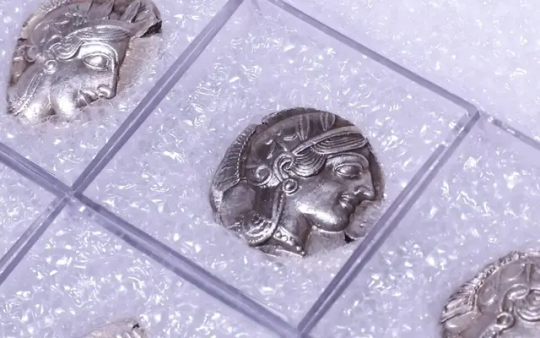
Broadly used
Most of the cache were tetradrachms — ancient large silver coins — originally minted in Athens and used broadly in the eastern Mediterranean, said Museum Numismatologist Vassiliki Stefanaki, a coinage expert.
Stamped with the image of an owl, the Athenian relics were also used locally to pay tribute to the Persian Empire, and Persian governors used them to reward their troops, she said.
Other coins came from Cyprus, the islands of Aegina and Milos, from Asia Minor cities founded by Greek settlers, the Iron Age kingdom of Lydia, and Phoenicia in modern-day Lebanon, officials said.
Mendoni on Thursday also thanked Turkey for supporting Greece’s campaign to secure the return of the Parthenon Marbles from London.
The British Museum has long maintained that the Marbles were removed from the Acropolis in Athens by royal decree granted to Lord Elgin, the British ambassador to the Ottoman Empire.
But in June, Zeynep Boz, the head of the Turkish Culture Ministry’s anti-smuggling committee, told a UNESCO meeting in Paris that no such document had been found in Ottoman archives.
Her statement was “decisive” in favor of Greece’s position, Mendoni said Thursday.
Ersoy through a translator said Turkey wanted “with all its heart” to see the Marbles return to Athens.
“The Greek people should have them, they belong to them,” he said.
Boz, who attended Thursday’s ceremony in Athens, told Agence France-Presse that the timing of the coins’ return by Greece was not related to her report in June.
The five-year delay was caused by the time required by the Greek justice system to authorize the coins’ repatriation, she said.


#Greece Returns 1055 Ancient Coins to Turkey#silver#silver coins#ancient coins#ancient artifacts#tetradrachms#Persian Empire#archaeology#archeolgst#history#history news#ancient history#ancient culture#ancient civilizations#looted#stolen
80 notes
·
View notes
Text
okay I am engaging in some public accountability because I have a ridiculous number of WIPs and I actually want to get some of them done. so I'm going to list out all of the WIPs I consider to be active, and by the end of the year I hope to have at least 5 of them finished and published
DCU:
Batfam PJO AU [outlining+writing stage, 500 words in]
Bruce, Harvey, and the RY1 Aftermath Fic [ideas stage, outlining]
Damian and Tim Time Travel [ideas stage, outlining]
Dick and Donna-5 Stages of Grief [ideas stage, outlining]
Donna and Tim Space-Time Road Trip [ideas stage, outlining]
Grayson+Ric Arc Fix It ft. Tim Trauma Run PART TWO [ideas stage, outlining]
Jason Paranormal Detective Agency WIP [outlining+writing, 1k words in]
Leave Me and Live (Jason) [writing, 7k words in]
Bruce Wayne Religion Discourse Fic [ideas stage, outlining]
The Rise of Oracle [outlining+writing, 800 words in]
To Look for Herself in the Sunrise (Cass) [writing, 5k words in]
universal donor (Dick) [ideas stage, outlining]
WW Antiquities Repatriation Saga [ideas stage, outlining]
Six of Crows:
Ghafa Parents Twoshot [ideas stage, outlining]
Horse Racing AU [outline done, 2k words in]
Kanej Snow Queen AU [ideas stage, outlining]
Kaz-Wesper Wedding Gift Fic [writing, 900 words in]
on the seas and in the city [outlining+writing, 4k words in]
Forced to Choose fic [writing, 19.5k words in]
To Build a Legend (Inej Knife Fic) [final editing stages, currently being published]
to love him is freedom (kanej) [writing, 7.6k words in]
Unorthodox Methods for Parenting Criminal Children [writing, 3k words in]
Other Fandoms:
Meanwhile in the Galactic Senate (Star Wars) [ideas stage, outlining]
The Last Jedi Reworking (Star Wars) [outline done, 3.5k words in]
De Rolo Trauma Electric Boogaloo (Critical Role/Legend of Vox Machina) [ideas stage, outlining]
De Rolo Favorite Siblings (Critical Role/Legend of Vox Machina) [ideas stage, outlining]
Susan Stays AU (Narnia) [outline done]
Problem of Susan Character Study (Narnia) [writing, 750 words in]
30 Years Later Interview (Hunger Games) [writing, 600 words in]
Endgame Revamp WIP (Marvel Cinematic Universe) [outline done]
#feel free to ask me about any of them at any time. I just needed to post the list SOMEWHERE public#my writing#personal#dc comics#six of crows#...I'm not gonna tag any of the others lmao
38 notes
·
View notes
Text
tumblr.com/join/JGYAhXSC
If you love art and antiques please join our community. No politics or porn just image’s and stories of beautiful and desirable objects.
Special emphasis on art thieves, forgers, oddball objects, academic art history, design analysis, repatriation and other art-law subjects .
5 notes
·
View notes
Text
Prosecutors in New York City have announced that they returned to Cambodia and Indonesia 30 antiquities that were looted, sold or illegally transferred by networks of American antiquities dealers and traffickers. The antiquities were valued at a total of $3m, Manhattan District Attorney Alvin Bragg said in a statement on Friday. Bragg said he had returned 27 pieces to Phnom Penh and three to Jakarta in two recent repatriation ceremonies, including a bronze statue of the Hindu deity Shiva, which was looted from Cambodia, and a stone bas-relief sculpture of two royal figures from the Majapahit empire, which reigned between the 13th and 16th centuries, that was stolen from Indonesia.
Continue Reading.
23 notes
·
View notes
Note
Fucking wild that in most of the US human bones are both cheaper and way easier to obtain than marine mammal parts.
YEAH. When I brought up the MBTA I wasn’t dissing it, even though I’m a taxidermy and bone collector I understand why protected species have prohibitions against the possession, sale and transportation of their remains. It’s vital to ecology. It is just truly insane to me that I cannot keep the feathers of a dead raven I found in a barn but human remains with no provenance are on display, for sale in antique stores and oddities shops across the US and at online boutiques.
I’m not against the possession or display of human remains by institutions involved in the arts and sciences but they should always be in the stewardship of cultural decedents of the deceased, repatriated immediately upon asking AND have provenance.
25 notes
·
View notes
Text
I'm very glad these things are being repatriated (although, really, not before time). That artefact is amazing!
7 notes
·
View notes
Text
It would pretty definitely get me kicked out, but I would love to take a group of people on a "Stolen Antiquities Tour" of the British Museum. We would go through the museum, and I would identify the artifacts, where they were stolen from, their cultural importance, how long they've been separated from their homeland, and which nation would very much like their things back now. If, by some miracle, I were to actually get to the end of the tour, I would conclude with a discussion about how the British Museum's refusal to return these items is just a modern continuation of their Imperialist history, laying claim to things they have no right to.
I would also strictly enforce a no harassing the staff policy. Most of them are just trying to make a living, and they are not the ones responsible for the refusal to repatriate artifacts. That decision is made higher up the chain.
#history#museum#british museum#artifacts#stolen cultural artifacts#i would totally do a series of museum tours if i could#because the us and france could definitely stand to return some things too#but no one pillaged cultures of their heritage quite like the british
8 notes
·
View notes
Note
https://www.instyle.gr/lifestyle/zendaya-sygklonizei-san-alli-niki-tis-samothr/
It's something trivial really Lancome comparing Greek statues on their models for a campaign, but i am still fascinated that Greek statues still are popular as a form of beauty.
At the same though it stills paints the belief that Ancient Greek beauty it's still pretty dominant. For example I haven't seen companies like Lancome saying they will compare models with Asian art or Scandinavian mythology, showing that still Western society still very actively uses ancient Greece for their standards.
Yeah though I think the reason for that could be that Greek Classical and Hellenistic art was the one more focused on realism. Ancient artefacts of Northern European and Asian and African cultures were often more abstract, so you can’t compare them successfully to actual people as much.
But apart from that, I just don’t like anything about this campaign, I am sorry for the negativity that follows. Lancôme appears so tone deaf. It chooses to collaborate with the Louvre at a time when the British museum has ridiculed itself internationally and more and more people ask for the repatriation of stolen antiquities.
And in the first two I was like “fine, they at least tried to keep the pretenses” because they chose Venus of Arles and Diane of Gabii, so statues that were discovered in France and Italy respectively.
However it is known that Venus of Arles is a Greek statue made and commissioned by Greeks and made of Hymettus marble. But it was unearthed there so I guess it’s fine.
Diane of Gabii is speculated to be the work of Praxiteles or one of his sons. And it was taken by the Prince Borghese who added it to his personal collection in Gabii, close to Rome. However, they can pull the card “we’re not sure about the attribution” on you so let’s say it’s fine.
The third one is fucking Venus de Milo which was unearthed in Milos, Greece in 1820 and was forcefully (with pressure and the threat of violence) sold to the French for a comparatively pretty low price (which btw has never been tracked by purchases, contracts or wills) given to the Greek farmer who dug it out and it was all during Ottoman times, so it’s not fine at all.
And then Zendaya flows her dress in front of Nike of Samothrace, another masterpiece that must return to its island of origin, to complete the sanctuary of the Great Gods, where it was found, and you have no idea how much I don’t care for Zendaya flowing a dress.
And besides how problematic and unoriginal it is as a campaign, for some reason none of the women (Zendaya, Amanda Seyfried and He Chong and anyone else in the video) look anything like the statues they are supposed to embody and be compared to so it is a fail on every aspect.
15 notes
·
View notes
Note
OFMD art heist!
This is my biggest WIP. It retells season 1 except Ed is a journalist on the heritage/antiquities beat by day and an art thief who steals looted artefacts to repatriate them by night and Stede is a guy who inherits his father's museum which turns out to be full of dubiously acquired antiquities. The crew all work at Stede's museum. This is the absolute most write-about-what-you-know AU for me. Here's a little excerpt:
Jim leads Ed to Stede’s office. Ed’s a professional, and he assesses everything about the space from the perspective of a man who would like to steal something from it, but he’s also so nervous about seeing Stede again that his palms are sweating through the cardboard cup holders on the two drinks he now feels absurd holding.
Stede’s door is open, and despite there being plenty of desks in the open plan office they’ve walked through, there are four employees crowded into Stede’s office, each seemingly doing their own thing. Two of them are just staring at their mobiles, and look up when Ed arrives; the other two have a conspicuously busy air about them.
Stede is seated at his desk, holding an office phone against his ear with a look of deep weariness. He has his personal mobile on the desk in front of him and seems to be in the act of typing – Ed’s mobile vibrates in his pocket – just as Stede looks up, sees him, and breaks into an enormous smile.
‘Ed,’ he mouths.
Ed feels himself grinning. He holds out both drinks and Stede cocks his head in confusion.
‘Latte?’ Ed whispers. ‘Or tea?’
The look of delight Stede gives him is worth all of it. Stede mouths ‘latte’ and Ed hands it to him, making sure their fingers brush.
11 notes
·
View notes
Text
US Hands Over Precious Cambodian Statues Worth Millions
27 Cambodian artifacts worth $2.4M, including Angkorian Buddhist and Hindu statues, set for repatriation from New York.
via Khmer Times, 24 April 2024: The Manhattan District Attorney’s Office in New York has facilitated the return of 27 valuable Cambodian artifacts, totaling $2.4 million. This repatriation involves Buddhist and Hindu statues, including rare Angkorian pieces, thanks to the joint efforts of various Cambodian and US agencies. The artifacts, which had been held by art dealers involved in illegal…

View On WordPress
0 notes
Text
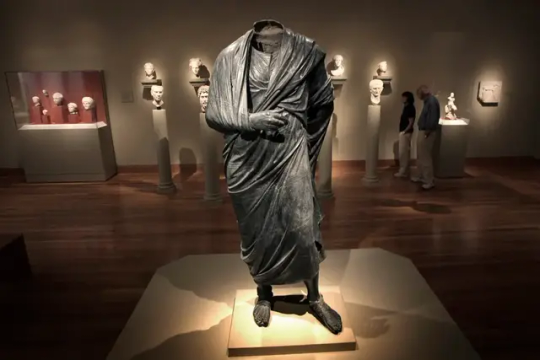
A Looted Bronze Statue That May Depict Marcus Aurelius Is Returning to Turkey
The repatriation comes after years of legal disputes over the true identity and provenance of the 6-foot-4 artwork, which has been housed at the Cleveland Museum of Art.
A headless bronze statue that may depict the Roman emperor and philosopher Marcus Aurelius will be repatriated to Turkey after an investigation determined that it had been looted, smuggled and sold through a web of antiquities dealers before arriving at the Cleveland Museum of Art in 1986.
The Manhattan district attorney’s antiquities trafficking unit first identified and took possession of the looted statue in 2023. But the statue remained in Cleveland while the museum challenged the seizure.
Last week, the museum relented and agreed to return the statue to Turkey. According to a statement, “new scientific testing” had revealed that the second-century C.E. statue was “likely present” at the Sebasteion, a shrine near the ancient Roman settlement of Bubon.
“The New York district attorney approached us with a claim and evidence that we felt was not utterly persuasive,” William M. Griswold, the director of the Cleveland Museum of Art, tells the Art Newspaper’s Daniel Grant. Officials then requested scientific tests to determine the validity of the claim.
All parties agreed that the scientific investigation would be led by Ernst Pernicka, an archaeologist and chemist who serves as the senior director and managing director of the Curt-Engelhorn-Center for Archaeometry in Germany.
As Pernicka tells the Art Newspaper, his tests followed a “well-established scientific procedure,” which included soil samples, lead isotope analysis and 3D modeling of the shrine site. Soil from within the statue matched soils in Turkey, and lead at the foot of the statue matched lead residue on a stone base where it may have been attached at the Sebasteion. Investigators also traveled to nearby villages to conduct interviews with locals who remember the looting.
Per the New York Times’ Graham Bowley and Tom Mashberg, the story goes something like this: Built nearly 2,000 years ago, the shrine featured bronze statues of Roman emperors, including Lucius Verus, Valerian and Commodus. An earthquake later buried the site, which was discovered by farmers in the 1960s. Villagers plundered the shrine and sold the bronzes to antiquities dealers like Robert Hecht, who faced allegations of smuggling before his death in 2012. After covert restoration in Switzerland and Britain, the items were sold to collectors and museums around the world.
With the statue of Marcus Aurelius returning to Turkey, the antiquities trafficking unit has seized 15 items looted from Bubon, collectively valued at nearly $80 million, according to a statement.


Turkish officials are celebrating the news. In a social media post, Minister of Culture and Tourism Mehmet Nuri Ersoy lauded the efforts to return the statue “to its rightful land,” per a translation by Türkiye Today. He added, “History is beautiful in its rightful place, and we will preserve it.”
In a legal sense, the case is closed. But mysteries about the bronze remain. The most glaring question: Who does the headless statue really depict?
When the Cleveland Museum of Art bought the statue from the Edward H. Merrin Gallery for $1.85 million in 1986, the receipt said “figure of a draped emperor (probably Marcus Aurelius), Roman, late second century [C.E.], bronze,” according to the Times. Standing at 6-foot-4, even without a head, it’s now thought to be worth around $20 million.
n its statement, the museum claims to have made a “relatively recent determination” that the statue is an unnamed philosopher rather than Marcus Aurelius. One stone base at the Sebasteion is inscribed with the ruler’s name, but the tests revealed that the statue was likely positioned on a different stone base without an inscription.
“Without a head or identifying inscription, the identity of the statue remains uncertain,” the museum adds.
However, Turkish officials dispute the museum’s claims, suggesting that the statue does depict Marcus Aurelius—both an emperor and philosopher—and may have been moved around between plinths, per the Times.
For now, the mysterious statue remains in the Cleveland Museum of Art. As Griswold tells the Art Newspaper, “The Turkish authorities are prepared to consider permitting the work to remain here in Cleveland for a brief period, so that our visitors may say farewell to the sculpture and so that we may explain to the public some of what we’ve learned in this process.”
By Eli Wizevich.

#A Looted Bronze Statue That May Depict Marcus Aurelius Is Returning to Turkey#Cleveland Museum of Art#Bubon Turkey#bronze#bronze sculpture#bronze statue#looted#stolen art#ancient artifacts#archeology#history#history news#ancient history#ancient culture#ancient civilizations#roman history#roman empire#roman art#ancient art
60 notes
·
View notes
Text
Mayorkas admits, “There is presently an acute and immediate need to construct physical barriers and roads in the vicinity of the border of the United States in order to prevent unlawful entries into the United States in the project areas…” and in order to complete the project, the administration is waiving the following statutes for the entirety of the project:
National Environmental Policy Act
Endangered Species Act
Federal Water Pollution Control Act
National Historic Preservation Act
Migratory Bird Treaty Act
Migratory Bird Conservation Act
Archeological Resources Protection Act
Paleontological Resources Preservation Act
Noise Control Act
Solid Waste Disposal Act
Comprehensive Environmental Response, Compensation, and Liability Act
Archaeological and Historic Preservation Act
Antiquities Act
Historic Sites, Buildings, and Antiquities Act
Farmland Protection Policy
National Fish and Wildlife Act of 1956
Fish and Wildlife Coordination Act
National Trails System Act
Administrative Procedure Act
Native American Graves Protection and Repatriation Act
American Indian Religious Freedom Act
Federal Land Policy and Management Act
The wall seems to be fairly important to permit the polluting of our environment, possible destruction of our historic sites and desecration of Native American Graves, and polluting of our waterways.
Im going to predict this section of wall is completely inconsequential in the grand scheme of things or useful for some other commie purpose. Including just a distraction. And in doing so they are violating 26 federal laws.
I don’t know if this was the same proposed location as “trumps wall” or if he would have needed to waive the same laws….but where’s the green agenda outrage in all this? Conveniently silent yet again of course.
9 notes
·
View notes